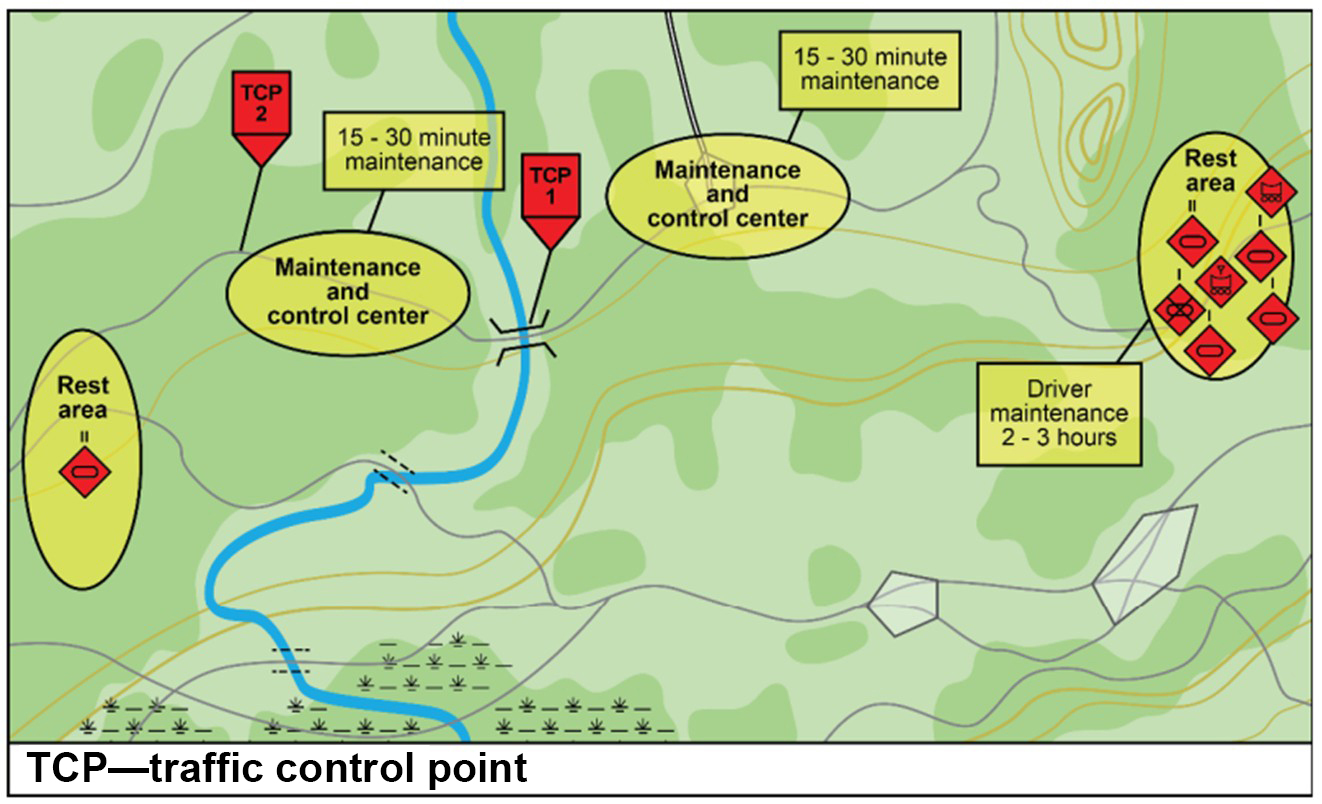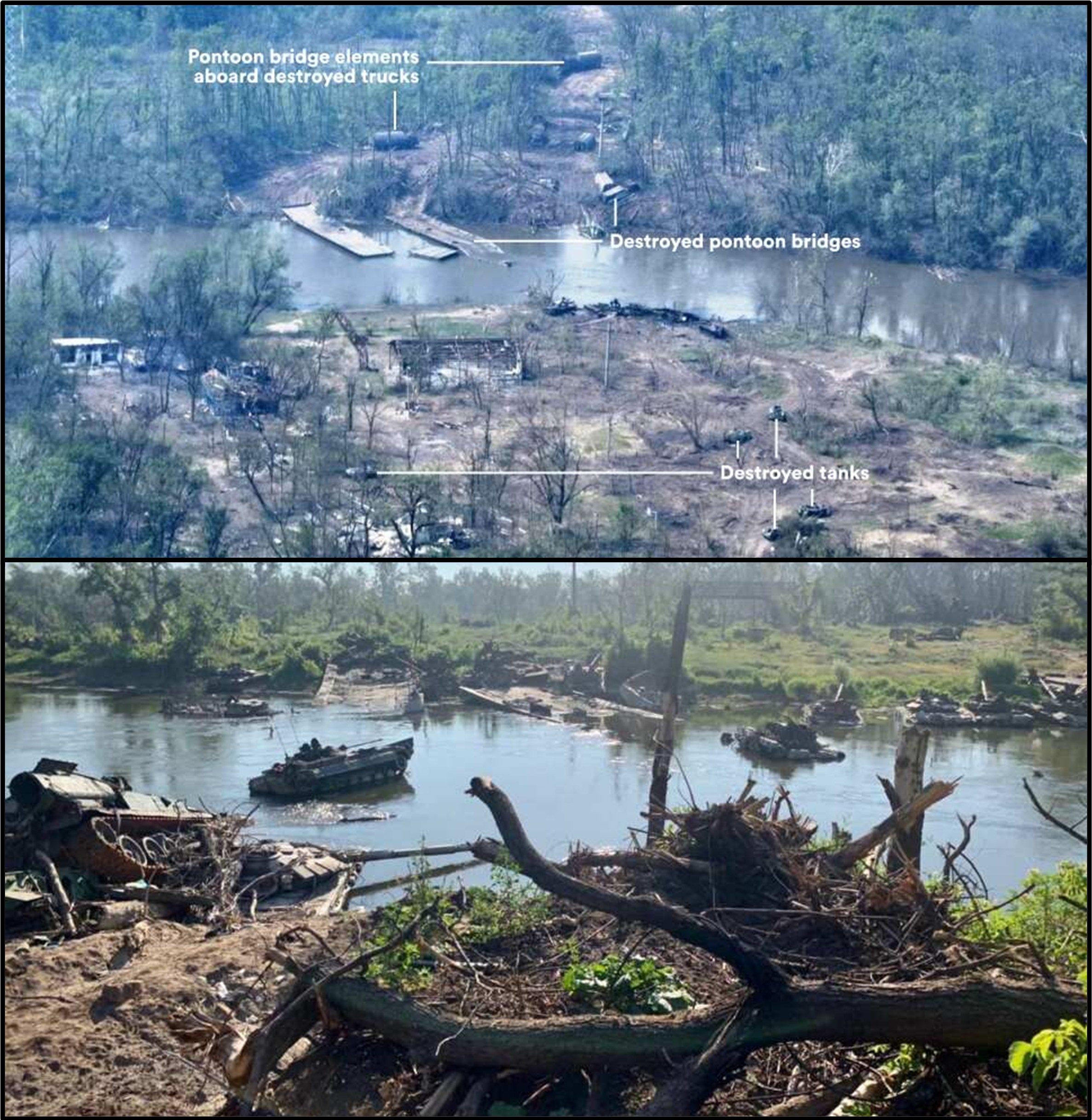Published 9/16/2025
Major Peter J. Witcomb
Introduction
On 24 February 2022, under the pretense of a ‘Special Military Operation,’ Russia commenced a full-scale invasion of Ukraine.1 Three months later, Ukrainian forces decimated a Russian battalion tactical group (BTG) attempting one of the most difficult military tasks in large-scale combat operations—a deliberate wet gap crossing.2 This article analyzes the Russian failed attempt to cross the Siverskyi Donets River, focusing on their failure to consider protection.3
First, this writing outlines the Russian operation through tactical analysis and open-source intelligence reporting. Next, it evaluates the operation against key protection considerations for the offense—specifically survivability, air and missile defense (AMD), and area security.4 Finally, it offers relevant lessons learned for protection during wet gap crossings. This analysis contributes to the Army’s professional discourse on the protection warfighting function by extracting insights from a contemporary tactical failure.
The Battle of Siverskyi Donets River
At the outset of the invasion, the advance on the Donbas axis in eastern Ukraine was a supporting effort aimed at enveloping Ukrainian forces through the Luhansk Oblast, rather than a frontal assault from the Russian-occupied Donbas region.5 However, by early May, this axis had become the main effort, with Russian forces attempting to encircle and seize Lysychansk and Severodonetsk.6

Russian unopposed river assault (ATP 7-100.1: Russian Tactics)
Heavy fighting occurred at Rubizhne and Popasna, where analysts anticipated further Russian offensives. Meanwhile, Ukrainian armed forces operating in Bilohorivka observed a Russian buildup west of the Siverskyi Donets River.7 In response, Ukrainian reconnaissance began scouting potential wet gap-crossing sites to anticipate where Russian forces might attempt to cross and advance toward Lysychansk and Severodonetsk.8 On 07 May 2022, Ukrainian engineers began terrain-focused reconnaissance in the vicinity of Bilohorivka to address a key priority information requirement: identifying potential Russian crossing points along the Siverskyi Donets River.9
The reconnaissance elements identified viable crossing points. The current and width (80 meters) of the river required engineer support—specifically, eight pontoons and powered watercraft—making this site the most likely crossing point.10
key difference between the Russian and U.S. approaches to wet gap crossings lies in their scale and complexity. The U.S. Army treats wet gap crossings as complex tactical actions requiring deliberate planning, often conducted at the division level.11 By contrast, the Russian approach to ‘Force Water Barriers’ details two primary tactics: unopposed assaults (against light or unorganized defenses) and opposed assaults (requiring a significant combined arms force).12 Russian forces also equip tanks and infantry fighting vehicles (IFVs) with snorkels or swim capabilities, enabling them to ford shallow rivers at the battalion level.13

Assessed Russian unopposed river assault plan—Siverskyi Donets River (Graphics: Major P Witcomb. Map: Google Maps)
However, Russian forces appear to have mistakenly assessed the Siverskyi Donets River as suitable for an unopposed crossing—a costly error.
On 08 May 2022, firsthand, but unverified, Ukrainian reports published on social media indicate that Ukrainian forces heard watercraft operating in the vicinity of Bilohorivka.14 They employed unmanned aircraft systems (UASs) to reconnoiter previously identified crossing areas and confirmed Russian bridging activity.15 Notably, Russian forces failed to apply the breaching fundamental of Suppress—there was no synchronization of direct or indirect fire against likely Ukrainian positions.16
They did, however, attempt to Obscure by utilizing natural obscuration (fog), deploying smoke grenades, and deliberately burning vegetation near the crossing site to shield their activity from observation.17 The most glaring failure was their disregard for Secure—a fundamental element of breaching. The inability to secure the crossing site contributed directly to the destruction of at least one BTG from the 74th Motorized Rifle Brigade. This can be directly attributed to a poor application of offensive protection considerations.18

The results of failing to consider protection (Photo credit: Conflict and Environment Observatory)
Analysis Through Protection Considerations for the Offense
Offensive operations require commanders to integrate robust protection measures designed to deny the enemy critical information while seizing opportunities through calculated risk and decisive action.19 Of the eight protection considerations for the offense, the failure to address survivability, AMD, and area security critically contributed to the inability of the Russian force to secure their designated crossing site.
- During offensive operations, forces enhance survivability by employing camouflage; utilizing cover and protective obstacles; and implementing emissions control, obscuration, deception, and dispersion.20
- AMD in the offense aims to shield friendly forces and critical assets from aerial and missile threats, denying enemy air surveillance and providing crucial early warning and reporting of ballistic missile activities. 21
- Area security supports offensive actions by providing a responsive protective capability for designated areas, routes, and critical assets, often using an economy of force to allow commanders to safeguard these elements without significantly diverting combat power.22
In practice, the brigade neglected core survivability principles, resulting in force concentration and vulnerability. Their lack of AMD allowed Ukrainian UASs to observe the crossing site and cue artillery strikes that destroyed equipment and personnel. Moreover, the brigade failed in area security, leaving both banks of the river exposed and enabling Ukrainian forces to destroy the bridgehead. The compounded failures forced the withdrawal of the 74th Motorized Rifle Brigade due to combat ineffectiveness and led to the abandonment of Russia’s broader encirclement plan for Lysychansk and Severodonetsk.23 The disastrous attempt to cross the Siverskyi Donets River underscores the critical importance of the protection warfighting function during offensive operations, offering key insights for any force conducting similar operations.
Lessons Learned: Protection and Wet Gap Crossings
1. Survivability is Nonnegotiable
The importance of survivability in the offense is as critical as it is in the defense. Russian forces failed to disperse or conceal their troops and equipment, leading to mass destruction. The lesson learned is that survivability cannot be an afterthought and demands planning and discipline. Survivability must be deliberately planned and executed—this includes effective camouflage, obscuration, and discipline in force dispersion.
2. AMD is Essential for River Crossings
The critical role that AMD plays in wet gap crossing operations is undeniable. Ukrainian UASs were instrumental in identifying Russian bridging efforts and directing precision fires. The inability of Russian forces to shield their operation from this aerial surveillance, or to counter the subsequent artillery barrages, proved catastrophic. A layered AMD capability is essential to detect, track, and neutralize aerial threats, particularly UASs, which are ubiquitous on the modern battlefield. Denying enemy air surveillance and providing early warning against aerial and missile threats are crucial to safeguarding both the crossing force and the critical, high-value bridging assets. Without this protective AMD umbrella, the entire operation remains exposed and presents a significant risk to the mission.
3. Area Security Enables the Mission
The failure to establish and maintain area security was a decisive factor. Russian forces failed to secure both the near and far sides of the crossing site, leaving the operation vulnerable to Ukrainian interference. This disregard for a critical breach fundamental allowed Ukrainian forces to effectively engage the pontoon bridges and the amassed troops with indirect fires. The core lesson here is that comprehensive area security must be established before bridging operations commence and then maintained throughout. This involves dedicating sufficient combat power to secure near and far side objectives within the crossing area, and protecting subsequent objectives from enemy influence across all domains. Securing the crossing site—a critical breaching fundamental—enables obstacle reduction and subsequent assault; ignoring it renders all other efforts futile.
Conclusion
The failed Russian crossing of the Siverskyi Donets River is a valuable case study on the imperative of integrating robust protection measures during offensive large-scale combat operations. The tactical failings can be attributed to critical deficiencies in the planning
and execution of survivability, AMD, and area security. Russian forces failed to implement fundamental survivability tactics—including dispersion and camouflage—rendering them highly vulnerable. Their inability to counter Ukrainian UASs and subsequent artillery strikes highlighted flaws in their AMD planning and execution. Furthermore, the failure to secure the crossing area allowed Ukrainian forces to effectively engage and neutralize the Russian attempts to cross. The lesson learned is that comprehensive planning and the diligent execution of survivability measures, layered AMD capabilities to counter threats such as UASs, and the establishment of thorough area security are not merely advisable—they are essential for the success of complex operations such as wet gap crossings. Overlooking these crucial protection elements invites catastrophic failure, as demonstrated by this pivotal event in the Russo-Ukrainian War.
Acknowledgment
The author utilized artificial intelligence tools (Google Gemini 2.5 Pro) to support the editing process and ensure formatting consistency in the preparation of this article. All arguments, analyses, and the final content remain the sole responsibility of the author.
Endnotes:
1Schmitt, ‘Russia’s “Special Military Operation” and the (Claimed) Right of Self-Defense’.
2Kindy, ‘Russian River Crossing Failure During the Battle of the Siverskyi Donets’; Centre for Army Lessons Learned, Crossing Under Fire, 1.
3Department of The Army, ADP 3-37, Protection, vii. Protection: The preservation of the effectiveness and survivability of mission-related military and nonmilitary personnel, equipment, facilities, information, and infrastructure deployed or located within or outside the boundaries of a given operational area.
4Department of The Army, 2-24–26.
5Institute for the Study of War, Russia Team, ‘Ukraine Conflict Update’, 2–3.
6Stepanenko, Hird, and Kagan, ‘Russian Offensive Campaign Assessment - 02 May 2022’, 5.
7Stepanenko, Hird, and Kagan, 5; Stepanenko and Kagan, ‘Russian Offensive Campaign Assessment - 13 May 2022’, 4; Altman, ‘Debacle On The Donets’.
8Altman, ‘Debacle On The Donets’.
9Altman.
10Altman.
11Centre for Army Lessons Learned, Crossing Under Fire, 1.
12Department of The Army, ATP 7-100.1: Russian Tactics, 7–21.
13Department of The Army, 7–21.
14Altman, ‘Debacle On The Donets’.
15Altman.
16Centre for Army Lessons Learned, Crossing Under Fire, app. B; Altman, ‘Debacle On The Donets’.
17Altman, ‘Debacle On The Donets’.
18Stepanenko and Kagan, ‘Russian Offensive Campaign Assessment - 14 May 2022’.
19Department of The Army, ADP 3-37, Protection, 2–24.
20Department of The Army, app. A.
21Department of The Army, app. A.
22Department of The Army, app. A.
23Defense Express, ‘Only Five Tanks Remained From the Russian 74th Motor Rifle Brigade After Meeting With Ukrainian Warriors’; Stepanenko, Kagan, and Barros, ‘Russian Offensive Campaign Assessment - 15 May 2022’, 1.
Major Witcomb is currently the Division Chief of the Engineer Captains Career Course at the U.S. Army Engineer School, Fort Leonard Wood, Missouri. He holds master’s degrees in project management from University of New South Wales, Sydney, Australia, and in military and defence studies from Deakin University.




